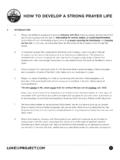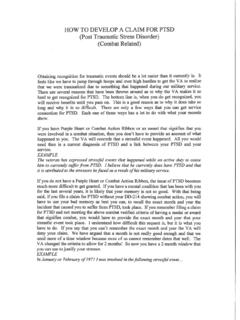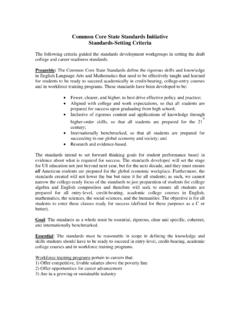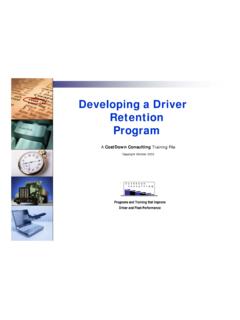Transcription of Conventional Prompt Global Strike and Long-Range Ballistic ...
1 Conventional Prompt Global Strike and Long-Range Ballistic Missiles: Background and Issues Amy F. Woolf Specialist in Nuclear Weapons Policy April 6, 2018 Congressional Research Service 7-5700 R41464 Conventional Prompt Global Strike and Long-Range Ballistic Missiles Congressional Research Service Summary Conventional Prompt Global Strike (CPGS) weapons would allow the United States to Strike targets anywhere on Earth in as little as an hour. This capability may bolster efforts to deter and defeat adversaries by allowing the United States to attack high-value targets or fleeting targets at the start of or during a conflict. Congress has generally supported the PGS mission, but it has restricted funding and suggested some changes in funding for specific programs.
2 CPGS weapons would not substitute for nuclear weapons, but would supplement Conventional capabilities. They would provide a niche capability, with a small number of weapons directed against select, critical targets. Some analysts, however, have raised concerns about the possibility that adversaries might misinterpret the launch of a missile with Conventional warheads and conclude that the missiles carry nuclear weapons. The Department of Defense (DOD) is considering a number of systems that might provide the United States with Long-Range Strike capabilities. The Air Force and Navy have both considered deploying Conventional warheads on their Long-Range Ballistic missiles.
3 The Air Force and the Defense Advanced Research Projects Agency (DARPA) sought to develop a hypersonic glide delivery vehicle that could deploy on a modified Peacekeeper land-based Ballistic missile, but test failures led to the termination of this program. In the mid-2000s, the Navy sought to deploy Conventional warheads on a small number of Trident II submarine-launched Ballistic missiles, but Congress rejected the requested funding for this program in 2008. Since then, the Pentagon has continued to develop a hypersonic glide vehicle, now known as the Alternate Reentry System, which could be deployed on Long-Range missiles. At present, it seems likely that this vehicle could be deployed on intermediate-range missiles on Navy submarines, for what is now known as the Prompt Strike Mission.
4 Congress may review other weapons options for the CPGS mission, including bombers, cruise missiles, and possibly scramjets or other advanced technologies. The Pentagon s budget request for FY2019 increases funding for the CPGS program from around $201 million in FY2018 to $278 million in FY2019; it also shows significant increases in funding over the next five years, with a total of $ billion allocated to the program. This shows the growing priority placed on the program in the Pentagon and the growing interest in Congress in moving the program forward toward deployment. When Congress reviews the budget requests for CPGS weapons, it may question DOD s rationale for the mission, reviewing whether the United States might have to attack targets promptly at the start of or during a conflict, when it could not rely on forward-based land or naval forces.
5 It might also review whether this capability would reduce reliance on nuclear weapons or whether, as some critics have asserted, it might upset stability and possibly increase the risk of a nuclear response to a attack. This risk derives, in part, from the possibility that nations detecting the launch of a PGS weapon would not be able to determine whether the weapon carried a nuclear or Conventional warhead. Congress has raised concerns about this possibility in the past. Warheads deployed on boost-glide systems would not be affected by the 2010 New START Treaty because these are new types of strategic offensive arms. But those deployed in existing types of reentry vehicles on existing types of Ballistic missiles would count against the treaty limits.
6 This report will be updated as needed. Conventional Prompt Global Strike and Long-Range Ballistic Missiles Congressional Research Service Contents Introduction .. 1 Background .. 2 The Prompt Global Strike Mission (PGS).. 2 Rationale for the PGS Mission .. 2 PGS and the Strategic Command .. 5 Potential Targets for the PGS Mission .. 5 Conventional Ballistic Missiles and the PGS Mission .. 6 Plans and Programs .. 9 Air Force Programs .. 9 The FALCON Study .. 9 Reentry Vehicle Research and Warhead Options .. 11 Missile Options .. 11 The Conventional Strike Missile .. 12 Hypersonic Test Vehicle (HTV-2) .. 13 ArcLight .. 15 Army Advanced Hypersonic Weapon.
7 15 Navy Programs .. 16 Reentry Vehicle Research .. 16 Conventional Trident Modification .. 18 Submarine-Launched Intermediate-Range Global Strike .. 19 Legislative Activity .. 21 FY2003 and 21 FY2005 .. 22 FY2006 and 22 FY2008 .. 24 FY2009 .. 25 FY2010 .. 26 FY2011 .. 26 FY2012 .. 27 FY2013 .. 28 FY2014 .. 28 FY2015 .. 29 FY2016 .. 29 FY2017 .. 30 FY2018 .. 31 FY2019 .. 31 Issues for Congress .. 32 Assessing the Rationale for CPGS .. 32 Reducing Reliance on Nuclear Weapons .. 32 PGS .. 33 The Potential for Misunderstanding a CPGS Missile Launch .. 34 Mitigating the Risks .. 35 Remaining Concerns .. 36 Reviewing the Alternatives .. 37 Land-Based Ballistic Missiles.
8 37 Submarine-Launched Ballistic 38 Conventional Prompt Global Strike and Long-Range Ballistic Missiles Congressional Research Service Long-Range Bombers .. 38 Tomahawk Cruise Missiles .. 39 Hypersonic Cruise Missiles .. 39 Scramjet Technologies .. 39 Forward-Based Global Strike (FBGS) .. 40 Arms Control Issues .. 40 Potential Threats from Hypersonic Strike .. 42 Weighing the Benefits and Risks .. 43 Contacts Author Contact Information .. 45 Acknowledgments .. 45 Conventional Prompt Global Strike and Long-Range Ballistic Missiles Congressional Research Service 1 Introduction Members of Congress and Pentagon officials have placed a growing emphasis on programs to develop hypersonic weapons as a part of an effort to acquire the capability for the United States to launch attacks against targets around the world in under an hour.
9 Hypersonic weapons can travel faster than Mach 5, or about 1 mile to 5 miles per This interest is driven by both the perceived mission need for Conventional Prompt Strike systems and concerns about falling behind Russia and China in the development of these The United States is pursuing two key technologies for this purpose: boost-glide systems that place a hypersonic glider atop a Ballistic missile booster and hypersonic cruise missiles that would use scramjet technologies. This report focuses, primarily, on the Pentagon s ongoing program to develop Ballistic missile-based Conventional Prompt Strike systems. This effort has been underway for about 15 years.
10 The George W. Bush Administration demonstrated an interest in the use of Conventional weapons for precision, Long-Range Strike missions in the 2001 Nuclear Posture Review (NPR). This study called for the integration of precision Conventional weapons with strategic nuclear forces in a new category of offensive Strike Several other Pentagon studies published during the Bush Administration also called on the United States to develop the capability to attack targets around the world, in under an hour, with Conventional warheads. The Obama Administration, in the 2010 NPR, also emphasized the role that Long-Range , non-nuclear systems could play in supporting regional deterrence and reassurance goals.


















